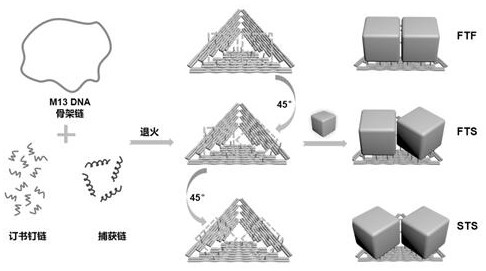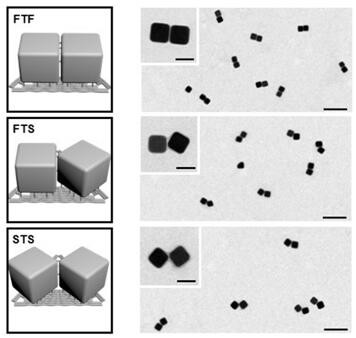A method for assembling nano-gold cubes to form dimer structures using DNA origami templates based on surface-enhanced Raman effects
A surface-enhanced Raman and nano-gold technology, which is applied in the field of DNA nanometers, can solve the problems of assembly neglect and achieve rich diversity, precise spatial addressability, and enhanced plasmonic effects
- Summary
- Abstract
- Description
- Claims
- Application Information
AI Technical Summary
Problems solved by technology
Method used
Image
Examples
Embodiment 1
[0031] Example 1: Preparation of triangular DNA origami with specific sites
[0032] Such as figure 1 Shown: Using phage M13mp18 single-stranded DNA as the backbone strand, it anneals with more than two hundred short scaffold strands and dozens of capture strands to form a triangular DNA origami. Its specific operation is:
[0033] (1) Mix M13mp18 bacteriophage circular single-stranded DNA, unmodified staple strand, and end-modified capture strand (Capture DNA) at a molar ratio of 1:10:10, that is, the added volume is 2.5 μL, 5 μL, 5 μL, then 10 μL 10×TAE-Mg 2+ Buffer (Mg 2+ concentration 12.5 mol / L), add ultrapure water to a final volume of 100 μL, shake well.
[0034] (2) Place the mixed solution in step (1) in a PCR instrument and anneal at a rate of 0.1°C / 10 s from 95°C to 20°C. After the reaction, use a 100 kDa ultrafiltration tube to centrifuge to remove excess staple chains. 4 ℃ for later use.
[0035] Among them, the sequence of the capture strand (Capture DNA) m...
Embodiment 2
[0039] Embodiment 2: Preparation of nano gold cubes modified by thiol DNA
[0040] In a certain buffer environment, thiol DNA single strands were added to modify the surface of the nano-gold cube, and the assembly was completed by adding salt (NaCl) aging to obtain a nano-gold cube covered with thiol DNA. Its specific operation is:
[0041] (1) Take 200 μL of 10 nm gold particles in a 1.5 mL centrifuge tube, centrifuge at 12000 rpm for 15 min, remove 120 μL of supernatant, add 10 μL of thiol DNA and 10 μL of 5×TBE (89 mM Tris, 89 mM boric acid, 2 mM EDTA, pH 8.0) buffer solution, shake to mix.
[0042] (2) Place the sample in step (1) in a mixer, and incubate at 37°C and 300 rpm for 4-6 hours.
[0043] (3) Add 10 μL of 3M NaCl solution to the sample incubated in step (2). Pay attention to adding 4 times, each adding 2.5 μL of 3 M NaCl solution at intervals of 30 minutes. Incubate overnight at 37°C. The purpose of adding salt (NaCl) step by step is to enable the assembly of ...
Embodiment 3
[0045] Example 3: Preparation of three dimer configurations
[0046] Such as figure 1 As shown, the thiol DNA-modified nano gold cube prepared in Example 2 was mixed with the triangular DNA origami prepared in Example 1, annealed and assembled. Its specific operation is:
[0047] The DNA origami and nano-gold cubes modified with sulfhydryl DNA were uniformly mixed in 1×TAE-Mg at a molar ratio of 1:2. 2+ In the buffer, the sample was placed in a PCR machine and annealed for 11 h. The annealing program was to cool from 45 °C to 20 °C at a rate of -0.1 °C / 10 s, and cycled for 4 cycles to completely hybridize the DNA origami and the nano-gold cube. The capture chains at different positions were designed on the surface, and finally assembled to form three kinds of nano-gold cubic dimers: face-face (FTF), face-edge (FTS) and edge-edge (STS).
PUM
 Login to View More
Login to View More Abstract
Description
Claims
Application Information
 Login to View More
Login to View More - R&D
- Intellectual Property
- Life Sciences
- Materials
- Tech Scout
- Unparalleled Data Quality
- Higher Quality Content
- 60% Fewer Hallucinations
Browse by: Latest US Patents, China's latest patents, Technical Efficacy Thesaurus, Application Domain, Technology Topic, Popular Technical Reports.
© 2025 PatSnap. All rights reserved.Legal|Privacy policy|Modern Slavery Act Transparency Statement|Sitemap|About US| Contact US: help@patsnap.com



